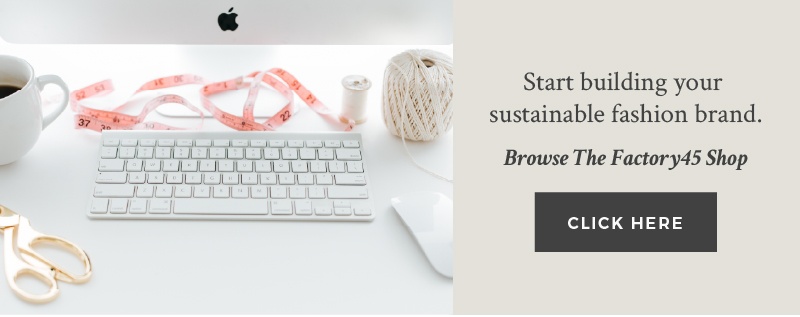Every year around this time, I try googling a list of fashion events happening around the world, and I’m never able to find a comprehensive list…
So, I put one together for us.
This list focuses mainly on sourcing, tradeshows and conferences with an emphasis on sustainable fashion, specifically.
I’ve also divided the events into USA and International — if there’s a tradeshow or conference that’s missing, please email me and I’ll add it to the blog post!
Enjoy,

*Designates the event being exclusively sustainable fashion-focused.
USA
Texworld USA
Jan. 19-21 | New York, NY
One of the largest sourcing events on the East Coast for apparel fabric buyers, product R&D specialists, designers, merchandisers and sourcing professionals.
DG Expo New York
Jan. 20-21 | New York, NY
The fabric show features North American and European Fabric and Trim Suppliers with Global Production. Including: Made in USA / Low Minimums + Stock Programs.
Premiere Vision New York
Jan. 21-22 | New York, NY
Six major industries supplying materials and services to the global fashion industry come together in New York.
MAGIC Las Vegas
Feb. 5-7 | Las Vegas, NV
MAGIC is the most comprehensive fashion marketplace in the U.S., showcasing Women’s and Men’s Apparel, Footwear, Accessories, and Sourcing resources from around the world.
COTERIE
Feb. 11-13 | New York, NY
The COTERIE Marketplace brings together all categories of women’s fashion under one roof.
*Impact Fashion Shop
March 14 | Los Angeles, CA
One of the leading sustainable fashion events in Los Angeles, this free pop-up shop brings the best impact-driven, environmental-friendly, fair trade brands under one roof.
DG Expo Dallas
March 25-26 | Dallas, TX
The fabric show features North American and European Fabric and Trim Suppliers with Global Production. Including: Made in the USA / Low Minimums + Stock Programs.
*Sustainable Fashion Forum
April 24-26 | Portland, OR
A highly-curated, community-driven sustainable fashion conference that looks to the future by fostering an honest, thought-provoking conversation about the social and environmental effects fashion has on our world and what we can do individually and collectively to improve it.
INTERNATIONAL
The London Textile Fair
Jan. 15-16 | London, UK
Provides manufacturers and their agents with the opportunity to showcase their products to the most influential British buyers and designers.
IM INTERMODA
Jan. 16 | Guadalajara, Mexico
IM INTERMODA, is the most important international platform in the fashion industry in Latin America.
Future Fabric Expo
Jan. 29-30 | London, UK
The Future Fabrics Expo is the largest dedicated showcase of globally sourced available sustainably and responsibly produced fabrics and materials.
Pure Origin
Feb. 9-11 | London, UK
The UK’s only fashion sourcing show to bring every element of the fashion supply chain together in one location.
Texworld Paris
Feb. 10-13 | Paris, France
One of the largest sourcing events in Europe for apparel fabric buyers, product R&D specialists, designers, merchandisers and sourcing professionals.
Premiere Vision-Paris
Feb. 11-13 | Paris, France
Six major industries supplying materials and services to the global fashion industry come together in Paris, the capital of fashion.
*Drapers Sustainable Fashion Conference
March 11 | London, UK
Brought to you by Drapers, the event is for fashion brands and retailers, clothes manufacturers, supply chain experts, innovators.
*The Australian Circular Fashion Conference
April 1-2 | Melbourne, Australia
The conference is specifically designed as a call to action for collaboration within the
Australasian textile and apparel industry.
Fashion World Tokyo
April 1-3 | Tokyo, Japan
FASHION WORLD TOKYO in Japan’s largest fashion trade show which consists of 6 specialized shows, held twice a year.
International Apparel & Textile Fair
April 7-9 | Dubai, UAE
Leading brand in the MENA region to source and showcase the best in textiles, fabric, footwear accessories and prints from renowned mills across the globe.
*Copenhagen Fashion Summit
May 27-28 | Copenhagen, Denmark
From CEO’s and creative directors to policymakers and thought leaders, the Summit brings together decision-makers from across the globe for agenda-setting discussions on the most critical environmental, social and ethical issues facing our industry and planet.
*MOCHNI Conscious Loft
July 4 | Hamburg, Germany
CONSCIOUS LOFT is a cozy 1-day event for people looking to connect, learn and shop in an intimate atmosphere. At CONSCIOUS LOFT you will feel consciously at home within a like-minded community.
International Sourcing Expo
Nov. 24-26 | Melbourne, Australia
The show provides an unmatched opportunity to meet and do business with some of the best suppliers from around the world in apparel, accessories and textiles.




















